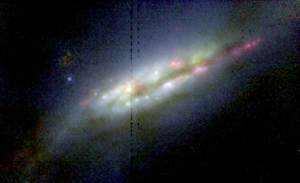NGC 2369
| Galaxy NGC 2369 |
|
|---|---|

|
|
| The center of NGC 2369 recorded in the infrared by the Hubble space telescope in false color representation: the wavelength 1.1 µm is assigned to blue, 1.87 µm to green and 1.9 µm to red | |
| AladinLite | |
| Constellation | Keel of the ship |
|
Position equinox : J2000.0 , epoch : J2000.0 |
|
| Right ascension | 07 h 16 m 37.7 s |
| declination | -62 ° 20 ′ 37 ″ |
| Appearance | |
| Morphological type | (R ') SAB (s) ab / LIRG |
| Brightness (visual) | 12.3 mag |
| Brightness (B-band) | 13.2 mag |
| Angular expansion | 3.5 ′ × 1.1 ′ |
| Position angle | 177 ° |
| Surface brightness | 13.6 mag / arcmin² |
| Physical data | |
| Affiliation | NGC 2417 group LGG 144 |
| Redshift | 0.010807 ± 0.000030 |
| Radial velocity | 3240 ± 9 km / s |
|
Stroke distance v rad / H 0 |
(135 ± 9) · 10 6 ly (41.4 ± 2.9) Mpc |
| history | |
| discovery | John Herschel |
| Discovery date | December 26, 1834 |
| Catalog names | |
| NGC 2369 • PGC 20556 • ESO 122-G018 • IRAS 07160-6215 • 2MASX J07163775-6220375 • GC 1518 • h 3078 • AM 0716-621, LDCE 0505 NED001 | |
NGC 2369 is a barred spiral galaxy of the Hubble type SBa in the constellation Carina in the southern sky . It is an estimated 135 million light years from the Milky Way and about 145,000 light years across.
The Type Ia supernova SN 2008cm was observed here.
The object was discovered on December 26, 1834 by astronomer John Herschel using a 47.5 cm telescope.
NGC 2369 group ( LGG 144 )
| Galaxy | Alternative name | Distance / million Lj |
|---|---|---|
| NGC 2369 | PGC 20556 | 135 |
| NGC 2381 | PGC 20694 | 130 |
| NGC 2417 | PGC 21155 | 133 |
| IC 2200 | PGC 21075 | 135 |
| PGC 21062 | IC 2200A | 135 |
| PGC 20640 | NGC 2369A | 131 |
